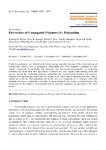Electronics of Conjugated Polymers (I): Polyaniline

View/
Date
2012-12Author
Molapo, Kerileng M.
Ndangili, Peter M.
Ajayi, Rachel F.
Mbambisa, Gcineka
Mailu, Stephen M.
Njomo, Njagi
Masikini, Milua
Baker, Priscilla
Iwuoha, Emmanuel I.
Metadata
Show full item recordAbstract
Conducting polymers have elicited much interest among researchers because of their reasonably good conductivity, stability, ease of preparation, affordability and redox properties compared to other organic compounds. In particular, the electronic and electrochemical properties of conducting polymers have made them find applications in photovoltaic cells, organic light emitting diode and sensors. Among the conducting polymers, polyaniline has received much attention and intensive research work has been performed with the polymer in its native state or functionalized form. This is mainly due to the fact that polyaniline and its derivatives or composites or co-polymers with other materials are easy to synthesise chemically or electrochemically by oxidative polymerisation. The mechanism for the synthesis of polyaniline and its electronic properties are presented in this short review.
